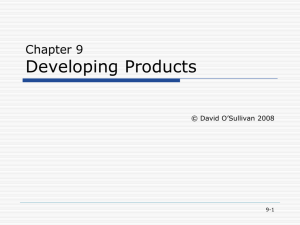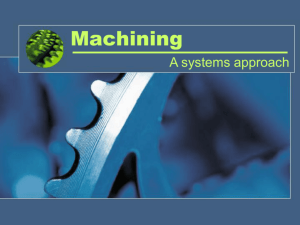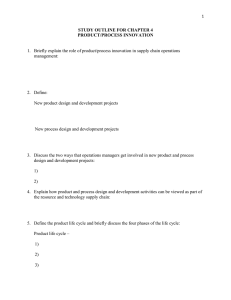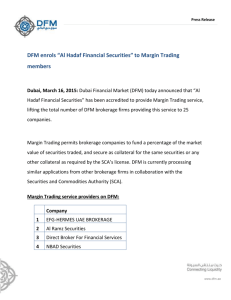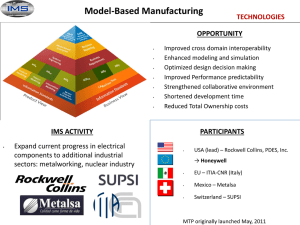DFM class - San Jose State University
advertisement
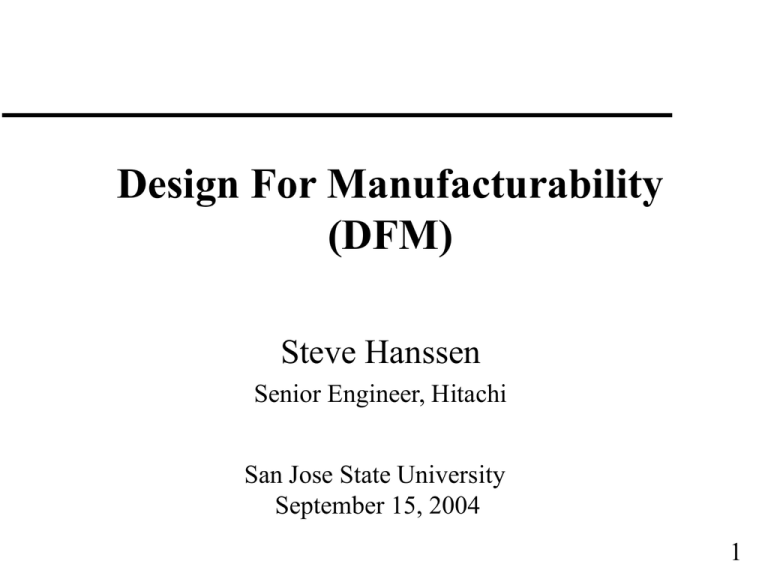
Design For Manufacturability (DFM) Steve Hanssen Senior Engineer, Hitachi San Jose State University September 15, 2004 1 Agenda Introduction What is DFM? Why use DFM? DFM Process DFM Approach, DFM Tools and Methods Summary Overview and DFM comparison table Where can I get more information? Resources, DFM Pro’s and Con’s and Comparisons 2 Introduction What is DFM? DFM is product design considering manufacturing requirements DFM is the first step in which a team approach is taken to develop the product DFM is an umbrella which covers a variety of tools and techniques to accomplish a manufacturable product Why DFM? Lower development cost Shorter development time Faster manufacturing start of build Lower assembly and test costs Higher quality 3 Introduction How do all the pieces fit together? The objective of DFM is to identify product concepts that are easy to manufacture Focus on component design for ease of manufacture and assembly Integrate manufacturing to ensure the best match of needs and requirements. DFM in industry is typically divided into 2 main activities: A team which will be responsible for the product development and delivery. (cross functional team: ME, EE, MFG., CE, PE, Quality) The tools and methods to enable DFM that ensure the design meets the objectives. 4 Introduction How much do engineering changes cost after the design has been launched? 10000 9000 8000 7000 6000 5000 4000 3000 2000 1000 0 Cost Design Test Tool Build Prod 5 Introduction When has the total cost be committed? 100 90 80 70 60 50 40 30 Incurred Commit 20 10 0 Design Testing Tool Build Production 6 Introduction Which is the better process? Number of Changes 100 80 60 traditional optimized 40 20 0 -20 -10 -5 0 5 Product Launch 7 Introduction Manufacturing Today Global Competition Trade barriers have been removed (NAFTA) Must compete with the best from all over the world Japan, Europe, India, Mexico, etc Infrastructure's forming off shore Quality Requirements ISO 9000 Six Sigma (Motorola Inc) Product Cycles Every generation is faster Rate of change is increasing Cost Costs decrease every year (customers expect costs to go down) Performance increasing every year 8 Introduction: Global Manufacturing Mfg: China, Ireland Mfg: China Mfg: China, Ireland Mfg: Mexico, China, Taiwan, Philippines Mfg: Japan, Thailand, Germany, Philippines Mfg: Malaysia Mfg: Singapore, Thailand Mfg: Thailand, Singapore, Hungary, Philippines 9 Introduction: Product Design Product Design Today Development Cycle Endless engineering changes Non standard parts have long lead times Quality “Designed and thrown over the wall” Lower due to more parts, manual processes, and untested parts Customer configuration management Cost Higher due to unique designs and specialized parts Equipment and Tooling Reliability and quality problems 10 DFM Typical Approach Product Development Process Conceptual DESIGN and development Product optimization, TEST TOOL BUILD (ease of assembly) LAUNCH, ramp, ship, and deliver Product Development team making it happen!! - Product requirements and deliverables - DFM tools and methods Product Team Product requirements and deliverables Collaborative cross functional team (ME, EE, MFG, Test, Quality, etc.). Not “designed in a vacuum” Uses DFM tools and methods start finish Design Test Tool Build Launch Product Development Steps 11 DFM Product Considerations Product Considerations Environmental Ergonomics Safety Pollution Recycling Shock/vibration Temperature Customer Depth of product line Customization Test requirements Suppliers Process and Tooling Cycle time Quality Ease of Assembly Ease of Testing Rework Shipping and Handling Tooling Costs Partnerships Supplier tolerance capability Merging mechanical sub-assemblies Costs 12 DFM Tools and Methodology Tools and Methodologies Design For Assembly (DFA), (IBM experience) Failure Mode and Effect Analysis (FMEA), (Sun example) Taguchi Method, (Hitachi experience) Value Analysis--”Value Engineering” (HP example) Quality Function Deployment (QFD), Going to the Gemba (Hitachi) Group Technology, (IBM example) Cost management and optimization, SPC, Six-Sigma (Motorola), TQC, etc 13 DFM Tools: DFA Guidelines - One assembly direction “tops down” -No adjustments required -No hidden features - Standard parts (one screw type) - Test direction access from top - Parts are self-guiding - Sub-assemblies reduce handling of small hard to grip parts - Holes large enough (straightness issues if too deep) - Common datum’s for all fixtures -One common plane for assembly - Tabs for robotic lift - Easy to fabricate parts - Avoid tangle with use of fixtures - Symmetry in two axis -Die cast with minimal amount of holes (debris chip) -Standard cutters -Guide features - bottom rails for conveyor 14 DFM Tools: DFA Guidelines Summary of DFA Guidelines 1. Minimize the number of parts 2. Standardize and use as many common parts as possible 3. Design parts for ease of fabrication (use castings without machining and stampings without bend) 4. Minimize the number of assembly planes (Z-axis) 5. Use standard cutters, drills, tools 6. Avoid small holes (chips, straightness, debris) 7. Use common datum’s for tooling fixtures 8. Minimize assembly directions 9. Maximize compliance; design for assembly 10. Minimize handling 11. Eliminate adjustments 12. Use repeatable, well understood processes 13. Design parts for efficient testing 14. Avoid hidden features 15. Use Guide features 16. Incorporate symmetry in both axis 17. Avoid designs that will tangle. 18. Design parts that orient themselves 15 DFM Tools and Methodology FMEA (Failure Mode and Effects Analysis) Method for analyzing the causes and effects of failures. Highlights designs and assemblies most likely to cause failures. Helps identify and prioritize corrective action Indicates where the most improvement in terms of severity, frequency, and detectability can be made. Widely used manufacturing technique (Mil standards, SAE, ANSI Specs) 16 DFM Tools and Methodology FMEA Method On the next page is a simple example of FMEA for a Disk Drive Actuator assembly Here’s the method I used: Adopt a correlation scoring system between parts and failure modes. A system commonly used is: 9 for a “A”- indicates a strong correlation. 3 for a “B”- indicates some correlation. 1 for a “C”- indicates possible correlation Apply a weighting to the parts. For example, 1, 4, 9, 16, where 16 is more important than 1. Sum these horizontally to give a gross weight for each part. Calculate the percentages in the right-hand column. The percentages prioritize the areas to which attention should be given. 17 DFM Tools and Methodology FMEA for a Disk Drive Actuator Assembly Failure modes Weight according to importance Assembly components Parts Weight Flux clean 16 A/144 Heat sink 16 A/144 A/144 Solder 4 C/12 C/12 Holder 9 Cable align Bent HGA Touch up Flash Gross Weight Percent C/48 A/144 336 42 288 36 96 12 81 10 A/36 A/36 A/81 Most correlations, but not the highest priority totals 801 should be given highest priority 100 18 Summary What is DFM? Design considering manufacturing Why DFM? Shorter Development Cycle Lower costs and higher quality Fewer Engineering Changes DFM Approach “Integrated” in product design process. Not “designed in a vacuum” Tools and Methods Design is the first manufacturing step. The essence is use a combination of tools and methods which are appropriate for your application 19 DFM Tools Pro’s and Con’s DFM Tools Pro’s and Con’s Technique Advantage Disadvantage Guidelines Cost and Effort Management Team Approach Systematic Narrows possibilities Systematic Priortizte corrective action Provides guidance Exceptions to list Taguchi FMEA Management “Buy-in” Designer Effort Management Rates only ease of assembly 20 DFM Tools: Comparisons DFM Tools Comparison Table DFM ACTIVITY DFM TOOLS PRODUCT CONCEPT DESIGN GUIDELINES DESIGN FOR ASSEMBLY TAGUCHI CUMPUTER AIDED DFM GROUP TECHNOLOGY FMEA VALUE ANALYSIS X X X X X SIMPLIFY CONCEPT PROCESS NEEDS FUNCTIONAL NEEDS X X X X X X X X X 21 References A Few DFM References Baer, T., “With Group Technology Nobody Reinvents the Wheel.” Mechanical Engineering, November 1995. Boothroyd, et al., “Computer Aided Design for Assembly.” Assembly Engineering, February, 1993. Boothroyd, et al., “Design for Assembly: Selecting the Right Method.”, Machine Design, December, 1983. Boothroyd, G. “Make it Simple Design for Assembly.” Mechanical Engineering, February 1988. Gage, W.L., “Value Analysis, McGraw-Hill, Inc, New York, 1967. Owen,T., “Assembly With Robots.” Prentice-Hall, Inc., Englewood NJ, 1985 Burgam, P.M.,Design of Experiments-The Taguchi Way.” Manufacturing Engineering, May, 1985 Evens, B., “Simultaneous Engineering.” Mechanical Engineering, February 1985. Stoll, H.W., “Design for Manufacture.” Manufacturing Engineering, January 1988. Boothroyd, G., “Design for Assembly.” Mechanical Engineering, February 1988. Barkan, P., “The Benefits and Limitations of Structured Design Methodologies.” ASME, Manufacturing Review, vol. 6, no. 3, September 1993. Baralla, J.G., “Handbook of Product Design for Manufacturing.” McGraw-Hill, 1988. Harry, M.J., “The Nature of Six Sigma Quality.” Motorola, Inc., Government Electronics Group. Donnelly, T.A., “Robust Product Design.” Machine Design, October 8, 1988. Sadri,H, et al., “Design of Experiments: An Invaluable.” Production Engineering, February 1994. Box G., et al., “Statistical Tools for Improving Designs.” Mechanical Engineering, January 1988. Miles, L.D., “Techniques of Value Analysis and Engineering, McGraw Hill, NY, 2nd ed., 1972. 22 I Want to Learn More! Where else? SCPD.stanford.edu, ME396 (DFM Forum) CACT Center, De Anza College, DFM Seminar University of Rode Island, DFA 23


